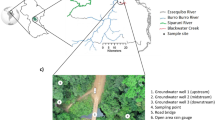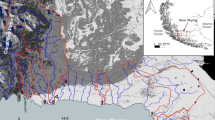Abstract
The stream–riparian interface, characterized by a dynamic and complex hydrology, is an important control point for nutrient fluxes and processing between terrestrial and aquatic systems. Predicted alterations in the discharge regime in Mediterranean climate regions make it necessary to understand the effects of abrupt hydrological transition between dry and wet conditions on the transport and fate of dissolved organic carbon (DOC) across the stream–riparian interface. In this study, the concentrations and fate of total DOC (TDOC) and a subset of four molecular weight fractions (<1 kDa, 1–10 kDa, 10–100 kDa, >100 kDa) were investigated in stream water and riparian groundwater during autumn of 2003 and 2004. The two study periods were characterized by contrasting antecedent hydrological conditions: the streamflow was interrupted in summer 2003 but was permanent in summer 2004. Comparison of the two study periods indicates that an abrupt dry–wet hydrological transition amplifies the water exchange across the stream–riparian interface and favors retention of up to 57% of the TDOC that flows across the interface. Furthermore, the efficiency of DOC retention across the stream-riparian interface also varies greatly depending on DOC molecular size. More than 70% of DOC fractions higher than 10 kDa were retained, whereas the smaller fraction (less than 1 kDa) was nearly conserved. Consequently, our study helps to clarify the effects of extreme hydrological events on DOC transport in running waters in Mediterranean regions.







Similar content being viewed by others
References
Acuña V, Giorgi A, Muñoz I, Uehlinger U 2004. Flow extremes and benthic organic matter shape the metabolism of a headwater Mediterranean stream. Freshw Biol 49:960–71
Amon RMW, Benner R 1996. Bacterial utilization of different size classes of dissolved organic matter. Limnol Oceanogr 41:41–51
Bernal S, Butturini A, Sabater F 2002. Variability of DOC and nitrate responses to storms in a small Mediterranean forested catchment. Hydrol Earth System Sci 6:1031–41
Bernal S, Butturini A, Riera JL, Vázquez E, Sabater F 2004. Calibration of the INCA model in a Mediterranean forested catchment. Hydrol Earth System Sci 8:729–41
Bernal S, Butturini A, Sabater F. 2005. Seasonal variations of dissolved organic nitrogen and DOC:DON ratios in an intermittent Mediterranean stream. Biogeochemistry 75:351–72
Boulton AJ, Findlay S, Marmonier P, Stanley EH, Valett MH. 1998. The functional significance of the hyporheic zone in streams and rivers. Annu Rev Ecol Syst 29:59–81
Burt TP, Pinay G, Matheson FE, Haycock NE, Butturini A, Clement JC, Danielescu S, Dowrick DJ, Hefting MM, Hillbricht-Ilkowska A, Maitre V. 2002. Water table fluctuations in the riparian zone: comparative results from a pan-European experiment. J Hydrol 265:129–48
Butturini A, Sabater F. 1999. Importance of transient storage zones for ammonium and phosphate retention in a sandy-bottom Mediterranean stream. Freshw Biol 41:593–603
Butturini A, Bernal S, Sabater S, Sabater F 2002. The influence of riparian-hyporheic zone on the hydrological responses in an intermittent stream. Hydrol Earth System Sci 6:515–25
Butturini A, Bernal S, Nin E. 2003. Influences of the stream groundwater hydrology on nitrate concentration in unsaturated riparian area bounded by an intermittent Mediterranean stream. Water Resour Res 39:1110, doi:10.1029/2001WR001260
Butturini A, Bernal S, Sabater F. 2005. Modelling storm events to investigate the influence of the stream–catchment interface zone on stream biogeochemistry. Water Resour Res 41:W08418, doi:10.1029/2004WR003842
Christensen JH, Christensen OB. 2003. Climate modelling: severe summertime flooding in Europe. Nature 421:805–06
Clark JM, Chapman PJ, Adamson JK, Lane SN. 2005. Influence of drought-induced acidification on the mobility of dissolved organic carbon in peat soils. Global Change Biol 11:791–809
Dahm CN, Grimm NB, Marmonier P, Valett MH, Vervier P. 1998. Nutrient dynamics at the interface between surface waters and groundwaters. Freshw Biol 40:427–51
Findlay S, Sinsabaugh RL, Sobczak WV. 2003. Metabolic and structural response of hyporheic microbial communities to variations in supply of dissolved organic matter. Limnol and Oceanogr 48:1608–17
Fischer HS, Steinberg CEW, Pusch M. 2002. Differential retention and utilization of dissolved organic carbon by bacteria in river sediments. Limnol Oceanogr 47:1702–11
Freeman C, Ostle N, Kang H. 2001a. An enzymatic “latch” on a global carbon store — a shortage of oxygen locks up carbon in peatlands by restraining a single enzyme. Nature 409:49–149
Freeman C, Evans CD, Monteith DT, Reynolds B, Fenner N. 2001b. Export of organic carbon from peat soils. Nature 412:785
Freeman C, Fenner N, Ostle NJ, et al. 2004.Export of dissolved organic carbon from peatlands under elevated carbon dioxide levels. Nature 430:195–98
Gasith A, Resh VH 1999. Streams in Mediterranean climate regions: Abiotic influences and biotic responses to predictable seasonal events. Annu rev Ecol Systems 30:51–81
Gordon ND, McMahon TA, Finlayson BL 1992. Stream hydrology. An introduction for ecologists. New Jersey: Prentice-Hall
Hefting M, Clement JC, Dowrick DJ, et al. 2004. Water table elevation controls on soil nitrogen cycling in riparian wetlands along a European climatic gradient. Biogeochemistry 67:113–34
Hill AR, Labadia CF, Sanmugadas K 1998. Hyporheic zone hydrology and nitrogen dynamics in relation to the streambed topography of a N-rich strea. Biogeochemistry 42:285–310
Hornberger GM, Scanlon TM, Raffensperger JP. 1998. Modelling transport of dissolved silica in a forested headwater catchment: the effect of hydrological and chemical time scales on hysteresis in the concentration-discharge relationship. Hydrol Processes 15:2029–38
Kaiser E, Arscott DB, Tockner K, Sulzberger B. 2004. Sources and distribution of organic carbon and nitrogen in the Tagliamento River, Italy. Aquatic Sci 66:103–16
Lake PS. 2003. Ecological effects of perturbation by drought in flowing waters. Freshw Biol 48:1161–72
McGlynn BL, McDonnell JJ. 2003. Role of discrete landscape units in controlling catchment dissolved organic carbon dynamics. Water Resour Res 39:1090
McGlynn BL, McDonnell JJ, Seibert J, et al. 2004. Scale effects on headwater catchment runoff timing, flow sources, and groundwater-streamflow relations. Water Resour Research. 40:7504–04
Neal C, Robson AJ, Neal M, et al. 2005. Dissolved organic carbon for upland acidic and acid sensitive catchments in mid-Wales. J Hydrol 304:203–20
Ninyerola M, Pons X, Roure JM 2000. A methodological approach of climatological modelling of air temperature and precipitation through GIS techniques. Int J Climatol 20:1823–41
Pastor J, Solin J, Bridgham SD, Updegraff K, Harth C, Weishampel P. Dewey B 2003. Global warming and the export of dissolved organic carbon from boreal peatlands. OIKOS 100:380–6
Romaní AM, Vazquez E, Butturini B. 2005. Changes in size fractionation and bioavailability of dissolved organic carbon after drought in a Mediterranean intermittent stream: biogeochemical link across the stream–riparian interface. Microb Ecol 52:501–512
Romano and Krol. 1993. Capillary ion electrophoresis, an environmental method for the determination of anions in waters. J. Chromatogr 649:403–12
Sabater S, Bernal S, Butturini A, et al. 2001. Wood and leaf debris input in a Mediterranean stream: The influence of riparian vegetation. Archiv Fur Hydrobiologie 153:91–102
Sabater S Butturini A, Clement JC, Burt T, Dowrick D, Hesfting M, Maitre V, Pinay G, Postolache C, Rzepecki M, Sabater F 2003. Nitrogen removal by riparian buffers under various N loads along a European climatic gradient: patterns and factors of variation. Ecosystems 6:20–30
Sachse A, Henrion R, Gelbrecht J, Steinberg CEW. 2005. Classification of dissolved organic carbon (DOC) in river systems: influence of catchment characteristics and autochthonous processes. Organic Geochem 36:923–935
Schindler JK, Krabbenhoft DP 1998. The hyporheic zone as a source of dissolved organic carbon and carbon gases to a temperate forested stream. Biogeochemistry 43:157–74
Sala M. 1983. Fluvial and slope processes in the Fuirosos basin, catalan ranges, northeast iberian coast. Z Geomorphol 27:393–411
Schröter D, Cramer W, Leemans R, et al. 2005. Ecosystem service supply and vulnerability to global change in Europe. Science 310:1333–37
Serrano SE, Workman SR 1998. Modeling transient stream/aquifer interaction with the non-linear Boussinesq equation and its analytical solution. J Hydrol 206:245–55
Sobczak WV, Findlay S 2002. Variation in bioavailability of dissolved organic carbon among stream hyporheic flowpath. Ecology 83:3194–209
Simon KS, Townsend CR, Biggs BJF, et al. 2005. Temporal variation of N and P uptake in 2 New Zealand streams. JNABS 24:1–18
Tranvik LJ, Jansson M 2002. Terrestrial export of organic carbon organic. Nature. 415:861–62
Tipping E, Rigg E, et al. 1999. Climatic influences on the leaching of dissolved organic matter from upland UK moorland soils, investigated by a field manipulation experiment. Environ Int 25:83–95
Valett HM, Baker MA, Morrice JA, Crawford CS, Molles MC, Dahm CN, Moyer DL, Thibault R, Ellis LM. 2005. Biogeochemical and metabolic responses to the flood pulse in a semiarid floodplain. Ecology 86:220–34
Vidon PGF, Hill AR. 2004. Landscape controls nitrate removal in stream riparian zones. Water Resour Res 40, doi:10.1029/2003WR002473
Wade AJ, Neal C, Butterfield D, Futter MN 2004. Assessing nitrogren dynamics in European ecosystems, integrating measurement and modelling: conclusions. Hydrol Earth Syst Sci 8:846–57
Wigington PJ, Griffith SM, Field JA, Baham JE, Horwath WR,Owen J, Davis JH, Rain SC, Steiner JJ 2003. Nitrate removal effectiveness of a riparian buffer along a small agricultural stream in Western Oregon. J Environ Qual 32:162–170
Acknowledgements
Thanks to two anonymous reviewers for their encouraging comments on an earlier version of the manuscript. This study was supported by funds provided the Ministerio de Educación y Ciencia (projects CGL2004-04050/HID, REN2002-04442-C02-02/GLO and CGL2005-06739-C02-02).
Author information
Authors and Affiliations
Corresponding author
Rights and permissions
About this article
Cite this article
Vázquez, E., Romaní, A.M., Sabater, F. et al. Effects of the Dry–Wet Hydrological Shift on Dissolved Organic Carbon Dynamics and Fate Across Stream–Riparian Interface in a Mediterranean Catchment. Ecosystems 10, 239–251 (2007). https://doi.org/10.1007/s10021-007-9016-0
Received:
Accepted:
Published:
Issue Date:
DOI: https://doi.org/10.1007/s10021-007-9016-0




